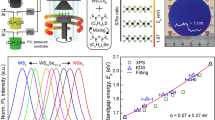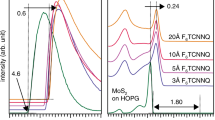Abstract
A broad range of transition metal dichalcogenide (TMDC) semiconductors are available as monolayer (ML) crystals, so the precise integration of each kind into van der Waals (vdW) superlattices (SLs) could enable the realization of novel structures with previously unexplored functionalities. Here we report the atomic layer-by-layer epitaxial growth of vdW SLs with programmable stacking periodicities, composed of more than two kinds of dissimilar TMDC MLs, such as MoS2, WS2 and WSe2. Using kinetics-controlled vdW epitaxy in the near-equilibrium limit by metal–organic chemical vapour depositions, we achieved precise ML-by-ML stacking, free of interlayer atomic mixing, which resulted in tunable two-dimensional vdW electronic systems. As an example, by exploiting the series of type II band alignments at coherent two-dimensional vdW heterointerfaces, we demonstrated valley-polarized carrier excitations—one of the most distinctive electronic features in vdW ML semiconductors—which scale with the stack numbers n in our (MoS2/WS2)n SLs on optical excitations.
This is a preview of subscription content, access via your institution
Access options
Access Nature and 54 other Nature Portfolio journals
Get Nature+, our best-value online-access subscription
$29.99 / 30 days
cancel any time
Subscribe to this journal
Receive 12 print issues and online access
$259.00 per year
only $21.58 per issue
Buy this article
- Purchase on Springer Link
- Instant access to full article PDF
Prices may be subject to local taxes which are calculated during checkout




Similar content being viewed by others
Data availability
Presented measurement data within this article and other findings of this study are available from the corresponding author upon reasonable request.
References
Ando, T., Fowler, B. & Stern, F. Electronic properties of two-dimensional systems. Rev. Mod. Phys. 54, 437–672 (1982).
Anderson, D. A. & Apsley, N. Electronics: semiconductor superlattices. Nature 305, 668–669 (1983).
Dingle, R., Störmer, H. L., Gossard, A. C. & Wiegmann, W. Electron mobilities in modulation-doped semiconductor heterojunction superlattices. Appl. Phys. Lett. 33, 665–667 (1978).
Mimura, T., Hiyamizu, S., Fujii, T. & Nanbu, K. A new field-effect transistor with selectively doped GaAs/n-AlxGa1–xAs heterojunctions. Jpn J. Appl. Phys. 19, L225–L227 (1980).
Faist, J. et al. Quantum cascade laser. Science 264, 553–556 (1994).
Köhler, R. et al. Terahertz semiconductor-heterostructure laser. Nature 417, 156–159 (2002).
Nakamura, S. The roles of structural imperfections in InGaN-based blue light-emitting diodes and laser diodes. Science 281, 956–961 (1998).
Khan, A., Balakrishnan, K. & Katona, T. Ultraviolet light-emitting diodes based on group three nitrides. Nat. Photon. 2, 77–84 (2008).
Abstreiter, G., Brugger, H., Wolf, T., Jorke, H. & Herzog, H. J. Strain-induced two-dimensional electron gas in selectively doped Si/SixGe1−x superlattices. Phys. Rev. Lett. 54, 2441–2444 (1985).
Zur, A. & McGuill, T. C. Lattice match: an application to heteroepitaxy. J. Appl. Phys. 55, 378–386 (1984).
Bauer, E. & van der Merwe, J. H. Structure and growth of crystalline superlattices: from monolayer to superlattice. Phys. Rev. B 33, 3657–3671 (1986).
Bae, S. H. et al. Graphene-assisted spontaneous relaxation towards dislocation-free heteroepitaxy. Nat. Nanotechnol. 15, 272–276 (2020).
Mendez, E. E. & Bastard, G. Wannier–Stark ladders and Bloch oscillations in superlattices. Phys. Today 46, 34–42 (1993).
Mak, K. F., Lee, C., Hone, J., Shan, J. & Heinz, T. F. Atomically thin MoS2: a new direct-gap semiconductor. Phys. Rev. Lett. 105, 136805 (2010).
Radisavljevic, B., Radenovic, A., Brivio, J., Giacometti, V. & Kis, A. Single-layer MoS2 transistors. Nat. Nanotechnol. 6, 147–150 (2011).
Britnell, L. et al. Strong light–matter interactions in heterostructures of atomically thin films. Science 340, 1311–1314 (2013).
Chhowalla, M. et al. The chemistry of two-dimensional layered transition metal dichalcogenide nanosheets. Nat. Chem. 5, 263–275 (2013).
Geim, A. K. & Grigorieva, I. V. Van der Waals heterostructures. Nature 499, 419–425 (2013).
Novoselov, K. S., Mishchenko, A., Carvalho, A. & Castro Neto, A. H. 2D materials and van der Waals heterostructures. Science 353, aac9439 (2016).
Yu, H., Wang, Y., Tong, Q., Xu, X. & Yao, W. Anomalous light cones and valley optical selection rules of interlayer excitons in twisted heterobilayers. Phys. Rev. Lett. 115, 187002 (2015).
Tran, K. et al. Evidence for moiré excitons in van der Waals heterostructures. Nature 567, 71–75 (2019).
Jauregui, L. A. et al. Electrical control of interlayer exciton dynamics in atomically thin heterostructures. Science 366, 870–875 (2019).
Heo, H. et al. Interlayer orientation-dependent light absorption and emission in monolayer semiconductor stacks. Nat. Commun. 6, 7372 (2015).
Cao, Y. et al. Unconventional superconductivity in magic-angle graphene superlattices. Nature 556, 43–50 (2018).
Cao, Y. et al. Correlated insulator behaviour at half-filling in magic-angle graphene superlattices. Nature 556, 80–84 (2018).
Schmidt, P. et al. Nano-imaging of intersubband transitions in van der Waals quantum wells. Nat. Nanotechnol. 13, 1035–1041 (2018).
Zultak, J. et al. Ultra-thin van der Waals crystals as semiconductor quantum wells. Nat. Commun. 11, 125 (2020).
Li, J. et al. General synthesis of two-dimensional van der Waals heterostructure arrays. Nature 579, 368–374 (2020).
Zhao, B. et al. High-order superlattices by rolling up van der Waals heterostructures. Nature 591, 385–390 (2021).
Kretinin, A. V. et al. Electronic properties of graphene encapsulated with different two-dimensional atomic crystals. Nano Lett. 14, 3270–3276 (2014).
Haigh, S. J. et al. Cross-sectional imaging of individual layers and buried interfaces of graphene-based heterostructures and superlattices. Nat. Mater. 11, 764–767 (2012).
Kang, K. et al. Layer-by-layer assembly of two-dimensional materials into wafer-scale heterostructures. Nature 550, 229–233 (2017).
Kang, K. et al. High-mobility three-atom-thick semiconducting films with wafer-scale homogeneity. Nature 520, 656–660 (2015).
Jin, G. et al. Atomically thin three-dimensional membranes of van der Waals semiconductors by wafer-scale growth. Sci. Adv. 5, eaaw3180 (2019).
Zhang, Z. & Lagally, M. G. Atomistic processes in the early stages of thin-film growth. Science 276, 377–383 (1997).
Xie, S. et al. Coherent, atomically thin transition-metal dichalcogenide superlattices with engineered strain. Science 359, 1131–1136 (2018).
Lu, A.-Y. et al. Janus monolayers of transition metal dichalcogenides. Nat. Nanotechnol. 12, 744–749 (2017).
Lee, C.-S. et al. Programmed band gap modulation within van der Waals semiconductor monolayers by metalorganic vapor-phase epitaxy. Chem. Mater. 32, 5084–5090 (2020).
Liu, K. et al. Evolution of interlayer coupling in twisted molybdenum disulfide bilayers. Nat. Commun. 5, 4966 (2014).
Vaziri, S. et al. Ultrahigh thermal isolation across heterogeneously layered two-dimensional materials. Sci. Adv. 5, eaax1325 (2019).
Schutte, W. J., De Boer, J. L. & Jellinek, F. Crystal structures of tungsten disulfide and diselenide. J. Solid State Chem. 70, 207–209 (1987).
Zou, X., Liu, Y. & Yakobson, B. I. Predicting dislocations and grain boundaries in two-dimensional metal-disulfides from the first principles. Nano Lett. 13, 253–258 (2013).
Kim, J. et al. Observation of ultralong valley lifetime in WSe2/MoS2 heterostructures. Sci. Adv. 3, e1700518 (2017).
Hong, X. et al. Ultrafast charge transfer in atomically thin MoS2/WS2 heterostructures. Nat. Nanotechnol. 9, 682–686 (2014).
Koma, A. Van der Waals epitaxy for highly lattice-mismatched systems. J. Cryst. Growth 201/202, 236–241 (1999).
Lin, Y.-C. et al. Realizing large-scale, electronic-grade two-dimensional semiconductors. ACS Nano 12, 965–975 (2018).
Mak, K. F. et al. Measurement of the optical conductivity of graphene. Phys. Rev. Lett. 101, 196405 (2008).
Acknowledgements
This work was supported by the Institute for Basic Science (IBS), Korea, under Project Code IBS-R014-A1.
Author information
Authors and Affiliations
Contributions
G.J., C.-S.L. and M.-H.J. conceived and designed the project. G.J., C.-S.L., S.-H.L. and M.Y.P. conducted the MOCVD growth experiments and material characterizations. O.F.N.O., D.-H.Y. and S.-Y.C. performed the TEM measurements and analysed the data. S.-Y.S., G.M. and S.Y.M. fabricated the devices and performed the optical measurements. H.A. performed the GI-WAXD measurements. S.C., C.H., J.L., J.K. and H.C. carried out the ultrafast laser spectroscopy. G.J., C.-S.L., S.C. and M.-H.J. wrote the paper. M.-H.J. supervised the project. All the authors discussed the results and commented on the manuscript.
Corresponding author
Ethics declarations
Competing interests
The authors declare no competing interests.
Additional information
Peer review information Nature Nanotechnology thanks Kian Ping Loh, Anlian Pan and the other, anonymous, reviewer(s) for their contribution to the peer review of this work.
Publisher’s note Springer Nature remains neutral with regard to jurisdictional claims in published maps and institutional affiliations.
Supplementary information
Supplementary Information
Supplementary Note, Figs. 1–29, Tables 1–3 and references 1–12.
Rights and permissions
About this article
Cite this article
Jin, G., Lee, CS., Okello, O.F.N. et al. Heteroepitaxial van der Waals semiconductor superlattices. Nat. Nanotechnol. 16, 1092–1098 (2021). https://doi.org/10.1038/s41565-021-00942-z
Received:
Accepted:
Published:
Issue Date:
DOI: https://doi.org/10.1038/s41565-021-00942-z
This article is cited by
-
Direct visualization of stacking-selective self-intercalation in epitaxial Nb1+xSe2 films
Nature Communications (2024)
-
Interlayer exciton dynamics of transition metal dichalcogenide heterostructures under electric fields
Nano Research (2024)
-
Stack growth of wafer-scale van der Waals superconductor heterostructures
Nature (2023)
-
Vapour-phase deposition of two-dimensional layered chalcogenides
Nature Reviews Materials (2023)
-
Synthetic two-dimensional electronics for transistor scaling
Frontiers of Physics (2023)



